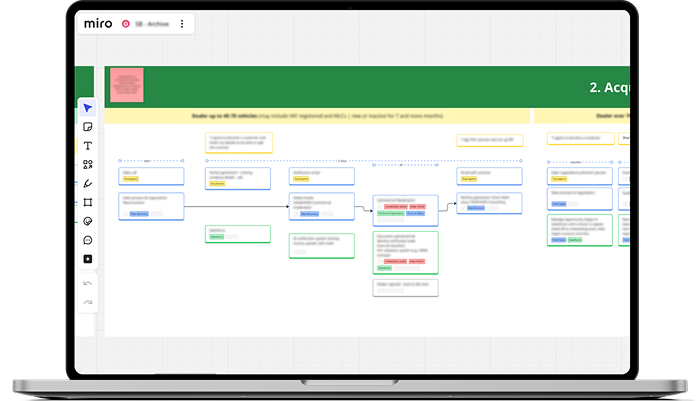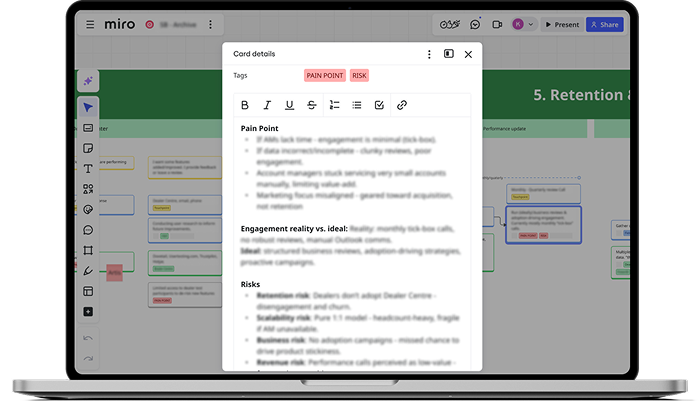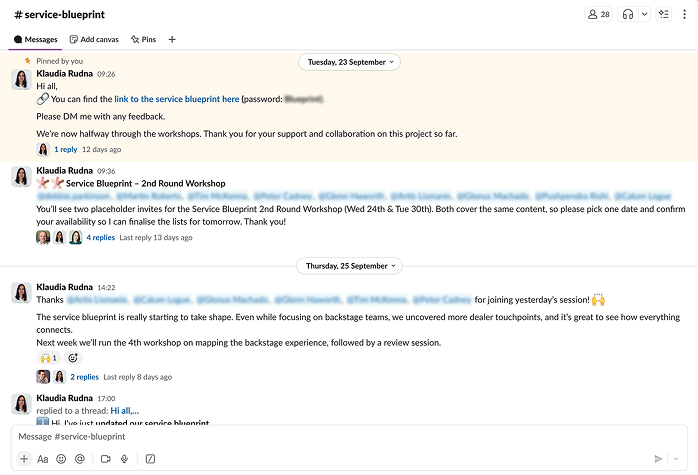CASE STUDY
Service Blueprint: From Fragmented Processes to Strategic Clarity
Aligned 28+ stakeholders across six departments, reduced manual work by 80%, and created a reusable service blueprint that turns complex systems into actionable business decisions.

CONTEXT & CHALLENGE
A Siloed View Blocking Strategic Decisions
The business lacked a single source of truth for customer journeys. Processes were siloed, ownership was unclear, and no visual framework connected customer touchpoints to the complex systems behind them.
The challenge was threefold:
- Misaligned expectations: Some stakeholders saw the blueprint as a tool to support a transition to a new pricing model, others wanted improvements to the current model.
- Timing risk: Mapping began late in the project, raising concerns from the project manager that new discoveries could delay delivery.
- Maturity gap: The business was accustomed to detailed customer journeys, but a service blueprint requires a higher-level, systems perspective. Managing expectations was critical.
MY ROLE
Leading Clarity from Discovery to Decision
My goal: build a service blueprint capturing customer and employee experience, systems, and processes — giving leadership a strategic tool to make informed, data-driven decisions.
I acted as strategist, facilitator, and designer of the blueprinting process, responsible for:
“This is a big undertaking, and you’ve put it together in a really short span of time… really, really good.” - Product Team

IMPACT
Reducing Manual Work by 80% and Unlocking £200k in Value
The blueprint delivered both immediate operational value and long-term strategic clarity - proving how structured collaboration and systems thinking can uncover measurable business impact.
Quantifiable Outcomes
- 28 stakeholders aligned across 6 departments, with 20 actively contributing through workshops and 1:1 sessions.
- 29 pain points and 6 critical risks identified — several directly linked to revenue leakage and customer retention.
- 70–80% reduction in repetitive manual work for the sales team, freeing 1.5–2.5 FTEs and generating an estimated £100k–£200k in annual savings.
Broader Business Value
- Consistency: automation reduces bias in lead scoring
- Morale: teams spend less time on repetitive admin, more on revenue-generating tasks
- Scalability: blueprint framework reusable across journeys and departments
- Customer Experience: faster onboarding, clearer journeys, improved conversion
APPROACH
Defining and mitigating project risks
Before mapping began, I analysed project risks and designed a structure to deliver fast, meaningful results within six weeks — aligning 28+ stakeholders while keeping the blueprint usable long after delivery.
Designing for Impact
Time was limited, so the focus was on achievability with strategic value.
Rather than capturing every detail, I prioritised an end-to-end view that revealed dependencies, inefficiencies, and automation opportunities leadership could act on immediately.
Detail was treated as a secondary layer — to be added once value was proven.
Stakeholder Management
The project involved the COO and six departments. I created a clear involvement map showing who contributed, reviewed, and approved each stage.
All workshops were scheduled in advance with two date options to reduce no-shows and maintain momentum.
Ownership was clarified early so everyone knew who was responsible for input and long-term updates to the blueprint.

I created a dedicated slack channel for stakeholders communication.
Managing Expectations
Different teams expected different outcomes — from a detailed process map to a strategic tool. At kick-off, I reframed the blueprint as a decision-support artefact, not a delivery blocker.
Success criteria were defined and validated via survey:
- Alignment and adoption by leadership
- Clarity of ownership across touchpoints.
- Use of blueprint in decision-making
Regular playback sessions kept expectations aligned and engagement high.
Scoping for Progress
To avoid scope creep, I split the work into two clear milestones:
- Current-state blueprint (first hand-off and validation milestone)
- Future-state vision (post-adoption iteration)
TThis phased delivery made progress visible and ensured focus on what mattered most.
Driving Adoption
Longevity was designed in from the start.
The blueprint lived in Miro, a tool already familiar across teams.
I introduced colour-coded templates and usage rules for consistency and ease of maintenance.
Cards allowed for links, ownership, and layered detail — keeping the map clean yet actionable.
Facilitation
Workshops followed a four-week cadence, mixing group sessions with 1:1s.
A test workshop validated clarity before scaling, and a progressive build approach prevented groupthink while maintaining momentum.
“Even just this call has been useful - hearing from people in areas I wouldn’t normally work with.”– Finance Team
Reflections & Learnings
The project validated that structure, facilitation, and framing are critical when introducing new ways of working in a complex environment.
What Worked
A structured facilitation approach — moving from individual input to group collaboration — kept conversations focused and inclusive.
Running a test workshop early on helped refine tools and prompts before scaling to larger groups.
The progressive blueprint build maintained momentum and allowed insights to surface organically, rather than forcing consensus too early.
Using Miro templates and rules ensured consistency, which made handover smooth and adoption straightforward.
What Was Challenging
Early sessions had unexpectedly high attendance, which required on-the-spot adaptation of facilitation methods and timing.
Some stakeholders initially expected a highly detailed process map, not a strategic artefact, so managing that transition in mindset took deliberate communication and steady reinforcement through playback sessions.
What I’d Do Differently
Next time, I’d run a pilot workshop earlier to validate assumptions about detail level and participant readiness before the main series.
I’d also set clearer expectations around fidelity from the outset to reduce rework and help teams focus on insight rather than precision.
Why It Matters
The project proved that even within tight timelines, it’s possible to turn fragmented processes and perspectives into a shared, actionable artefact that drives strategic decisions.
It showed how a well-facilitated blueprinting process can do more than visualise systems — it can shift how teams collaborate, prioritise, and deliver value.